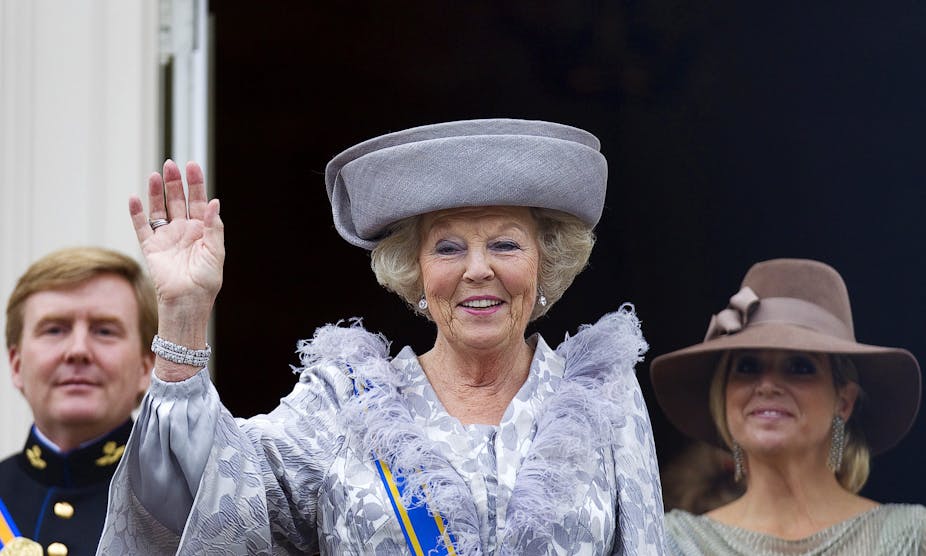April 30, 2013 - the annual Queen’s Day holiday - is an important date for the Dutch monarchy. Queen Beatrix of the Netherlands will formally abdicate her throne in favour of her son and heir, Willem-Alexander, Prince of Orange, whose inauguration follows immediately afterwards.
Beatrix’s announcement (made on January 28) of her intention to abdicate came as no surprise. Her grandmother, Queen Wilhelmina, began the practice of abdicating on Queen’s Day and her mother, Juliana, carried it on. Beatrix was expected to confirm the tradition. Like her forebears, Beatrix is long-lived (75 this year) and has been fortunate to enjoy a long reign (33 years). She has fulfilled the expectations of many in choosing the year of the bicentenary to make way for her son.
The day also marks the beginning of bicentennial festivities in honour of the royal dynasty, the House of Oranje-Nassau (or Orange), that are scheduled to conclude in late 2015. Together, these events constitute possibly the biggest concurrence of royal celebrations in the Dutch monarchy’s history.
Beatrix’s abdication marks the end of one of the longest periods of continuous female kingship in modern European history. Since 1890 a succession of “female kings” (koninginnen) have reigned in the Netherlands (Queen Regent Emma, Queens Wilhelmina, Juliana, and Beatrix herself). Willem-Alexander’s reign will be a masculine interlude, for his heir is another girl (Catharina-Amalia, born in 2003) who has two younger sisters.
Before 1890, the House of Orange had always been led by men – three kings named Willem. And before 1813, when the monarchy was established, the Oranje-Nassau dynasty had princely, not royal, status.
Its founder – another Willem (The Silent) – lived in the 16th century, and is popularly regarded today as the originator of the Dutch nation, a warrior-nobleman who led the Dutch revolt against Spain and won independence for his people. His descendants ruled as hereditary princes and stadhouders (stewards) who governed key provinces of what is now the Netherlands while remaining answerable to the Dutch parliament, the States-General. Indeed, apart from Willem III (1650–1702), who also reigned as King of England, Ireland and Scotland, most Princes of Orange were citizens of a Republic.
Following traditions established by Willem I, Beatrix and Willem-Alexander will embark on a tour of the country after his official ascension. The tour will extend to six islands in the Caribbean, the Netherlands Antilles, which are included in the Kingdom of the Netherlands. The islands are the last vestiges of an empire that has contracted significantly in the last half century. During the reign of Wilhelmina, the new king’s great-grandmother, this empire included the East Indies (from 1949, the Republic of Indonesia) and Suriname, a Latin American country that achieved independence in 1975, during the reign of Willem-Alexander’s grandmother, Juliana.
That the Dutch monarchy has a colonial past is just one trait that it shares with its British counterpart. The Netherlands too is a constitutional monarchy, but the democratic reputation that attaches to the House of Orange, at home as well as abroad, is arguably unique.
Having never reigned as absolute, sacralised sovereigns (ordained by divine right), Dutch monarchs are not “coronated” but “inaugurated” in a ceremony of “investiture”. In the Anglophone world the term “bicycle monarchy” has often been used to contrast Dutch royals with their grander European complements. Willem-Alexander’s grandmother, Queen Juliana, famously got about town as the majority of her subjects did – on a bike.

Many visitors to The Hague have unknowingly walked past Noordeinde, Beatrix’s “working palace”, because of its relatively modest front onto the main shopping street. And by international standards, the Dutch monarchy has often been regarded as relaxed and easy-going, a lesson that the British House of Windsor has only recently begun to emulate with the current Crown Prince William and his generation of royals.
Willem-Alexander will be a relatively young king (45) whose spouse, the Argentine Máxima Zorreguieta Cerruti, may not be a commoner (she’s descended from Iberian royalty), but is nonetheless popular among the Dutch in the same way that Crown Princesses Mary and Kate are in the United Kingdom and Denmark respectively.
All three sets of royal couples represent new styles of monarchy whose “ordinariness” resonates with a public who like their royals young, family-oriented, and explicit about viewing public service as their most important duty. As long as the new king adheres to this path and remains popular, the royal motto, “Je Maintiendrai” (I shall maintain), will be well chosen.

